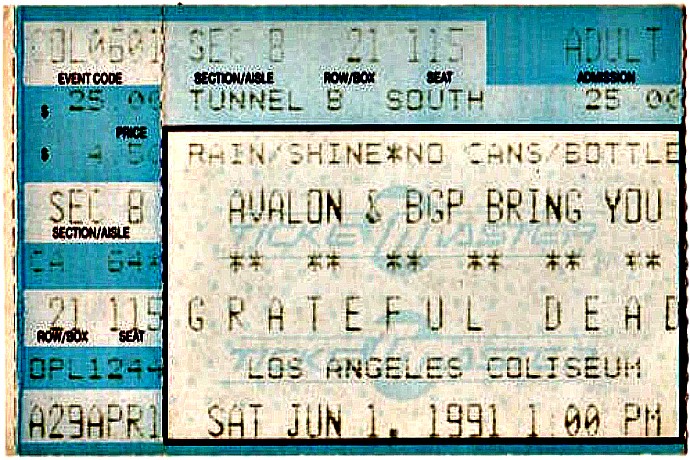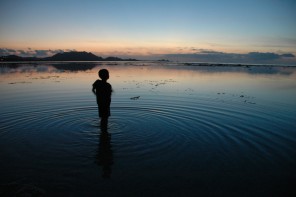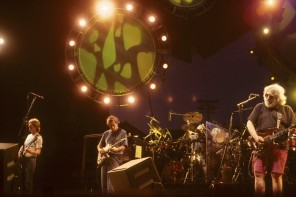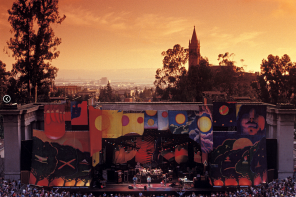~ from “Attics of My Life”
Full of tastes no tongue can know, and lights no eyes can see.
When there was no ear to hear, you sang to me.
I have spent my life seeking all that’s still unsung.
I was born in Tehran, Iran, to a Jewish family three years before the Islamic Revolution of 1979.
The history of the Jewish community in Iran is rich and complex. It is one of the world’s oldest Jewish communities, dating back 2,700 years to when the Jews were exiled from Jerusalem and settled in the Persian Empire.
From the 16th century, Iran was ruled according to Shiite Islamic doctrine, and the lives of Jews and other religious minorities were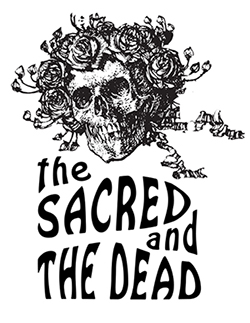 marked by periods of persecution and legal prohibitions. All of that changed when the Pahlavis came to power and attempted to eradicate religion from the public sphere. Reza Pahlavi (r. 1925-1941) and his son Mohammad Reza (r. 1941-1979) focused on secularizing, industrializing, and urbanizing the state. Thus, secularism and modern institutions replaced traditional sources of identity, such as ethnicity and religion.
marked by periods of persecution and legal prohibitions. All of that changed when the Pahlavis came to power and attempted to eradicate religion from the public sphere. Reza Pahlavi (r. 1925-1941) and his son Mohammad Reza (r. 1941-1979) focused on secularizing, industrializing, and urbanizing the state. Thus, secularism and modern institutions replaced traditional sources of identity, such as ethnicity and religion.
This was the Iran my parents lived in—the one where they did not experience anti-Semitism directly, where they were part of the fabric of Iranian society, and where they felt free to practice their religion. With the Islamic Revolution of 1979 and the consequent fall of Mohammad Reza Shah and the Pahlavi dynasty, 70,000 Iranian Jews fled the newly forming Islamic country and flocked to the United States, with Los Angeles having the highest concentration of Iranians in the United States.
This is where my story begins.
It was 1978 and my parents knew they had to leave Iran. They knew that the country was no longer a safe place for them. Unlike Iranians who tried to leave post-’79, our emigration was not dramatic. We applied for a green card and immediately left. We knew we had to leave as soon as we could, so we left everything behind: our home, our business, our land, clothing—everything. We arrived with nothing more than our suitcases and memories.
Like most Iranian Jews, my family settled in Los Angeles. My sister and I immediately were placed in a Jewish day school, and it was in this little family-oriented cocoon of a school that I prospered and lived my everyday life until high school.
It was high school that really changed my world. Here I was, attending a tiny Jewish day school from pre-school until 8th grade, with the same 10 kids every year, and now it is 1990 and I am attending Beverly Hills High School with more than 1,000 students in each grade.
The social landscape at Beverly Hills High School in the 1990s was insular and segregated. People from the same ethnic background tended to be friends only with each other and there was very little mixing between social groups. Most high school friendships had developed years earlier in elementary school, so the cliques were already established, and I was an outsider.
I didn’t fit in to any pre-established social hierarch, but when I looked at the Iranian Jewish kids, I couldn’t relate to them either.
Yes, I am an Iranian Jew. Yes, I came from that world, so by all means I should have been able to relate to those students—and yet I did not. But when I was with the “white” kids, I knew I was different because I did have Iranian Jewish parents and all the rules and restrictions that came along with that heritage.
As cool and open-minded as my parents were, they were still Iranian immigrants who held on to traditional beliefs. How could I explain to my peers that I couldn’t go out on a Friday night because I had Sabbath dinner or that the fabric and makeup of my family was just different than theirs?
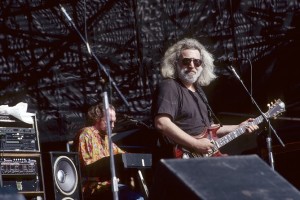
Jerry Garcia (right) and keyboardist Vince Welnick perform at the Los Angeles Coliseum on June 1, 1991. Photo by Herb Greene from the Grateful Dead Archive at UC Santa Cruz. Used with the gracious permission of the photographer.
So there I was, a 14-year-old freshman trying to figure out where I belonged. That all changed the day my sister came home with a CD copy of The Grateful Dead’s American Beauty.
She liked a senior and he liked the Dead. He introduced her to their music and she introduced them to me.
I remember sitting in the car and at home listening nonstop to the album. It was the first time music actually spoke to me. The irony, of course, was that the music I was listening to in the 1990 was from the 1970.
As a teenager, the popular music of the ’90s—grunge and “alternative” rock—were too dark and depressing for my tastes. I couldn’t relate. The same went for gangsta rap. At Beverly Hills High, most of my classmates dressed in their flannels and Doc Martens like they were headed to a coffee shop in Seattle. And then there was the clan of wealthy white male students, whose fathers were top doctors at the best L.A. hospitals or executives at the biggest movie studios, who let their pants sag, tagged anything that didn’t move with graffiti, seemingly wanting to rewrite their own history to appear as if they grew up on the streets of Compton instead of Rodeo Drive. Needless to say, I couldn’t relate to either group.
What I did relate to was the fusion of bluegrass, rock ‘n’roll, folk, and country music of American Beauty. My parents had no idea who the Grateful Dead were and thought it was so odd that their daughters were hooked on “country” music.
I went to my first Dead show in 1991 at the Los Angeles Coliseum, and that is where I found my “people” and my sense of belonging. It was the most thrilling and freeing experience of my high school life. The dancing, the moving, the drums, the parking lot scene where along with veggie burritos, beautiful beaded jewelry, and other crafts, I found a real sense of community.
If music can be an intoxicant, then American Beauty was my gateway drug. It introduced me to other Dead albums and I devoured each one. Eventually I found my fellow Deadheads at Beverly Hills High and we formed our own clique. We spent all of our free time traveling together to every Dead show within (teenage) driving distance: Shoreline, Oakland, Vegas, Laguna Seca.
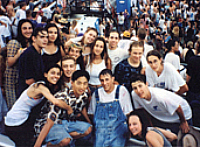
The author and some of her Deadhead friends at a Dead show in Las Vegas in 1993. Photo courtesy of the author.
It was through our love of the Dead that we formed a tribe of friends. We were a hodgepodge of Iranian, Korean, American, and Israeli kids bound together by our love of the band and bonded with each other by road trips where all 20 of us would crash in an EZ 8 motel in the middle of Oakland for days when the band was in town.
Even as we all went our separate ways after high school, we still would reunite at Dead shows. The concerts were a way of keeping us connected before the dawn of cell phones, the Internet, and Facebook made it so easy to keep in touch. That same group Deadhead friends from high school remain my closest and dearest friends to this day; we are aunts and uncles to each other’s children. (And yes: we all went together to the Santa Clara shows—the Dead’s last in California a week before their last concerts ever in Chicago over the July 4 weekend.)

The author (in front, left, wearing the hat) and some of her Deadhead friends from high school days at the Dead’s show in Santa Clara, Calif., last weekend. Photo courtesy of the author.
When it was time for me to choose a college, it wasn’t a difficult decision. I chose the University of California at Berkeley over UCLA because, well, the Dead played up north all the time and I could catch many more shows there than if I stayed in Los Angeles. I recall vividly the day Jerry Garcia died in 1995. My mother called me in the morning to send her condolences and make sure I was OK. She knew I would be devastated. Before we hung up, she gently asked me, now that Jerry had passed away, if I wanted to move back home and transfer to UCLA. I didn’t.
It was during my undergraduate studies in Berkeley and later in graduate school that I became interested in exploring my own history and culture. I spent much of my life traveling the world and studying different religious traditions. As a religious studies scholar, I started off wanting to focus on Hinduism and write about the Vedas and the Torah. But halfway through my graduate studies, I felt a yearning to examine my own history. I wanted to write about Iran, women in Iran, and the Jewish Iranian community in particular.
As a first-generation Iranian American, I have no memories of Iran. What I remember of Iran is gleaned from the collective oral histories that the matriarchs and patriarchs of my family passed down to me.
I have never returned to Iran. Sometimes it saddens me that I know India, Thailand, and other countries better than the place of my birth. I have never smelled the air at the Caspian Sea or walked through the bustling streets of Tehran. I have spent my academic career documenting the stories of immigrant Iranians as a way mitigating the absence of a country that is a part of my life, my culture, the language that I speak, and the food that I eat, but is not tangible to me in any way any more.
Recently I was listening to American Beauty again, as I revisited all of my old albums in preparation for the Santa Clara shows, and for the first time, a new song spoke to me: “Attics of My Life.”
With some of the most iconic Dead songs coming from that American Beauty, “Attics of My Life” somehow got lost in the shuffle for me. But as I listened to it again for the first time in a long time, I realized how much the story it tells spoke to my heart and to my sense of memory, history, longing, and belonging.
In many ways, Robert Hunter’s lyrics remind me of the Persian poets my father would recite to me—poets such as Rumi, Sadi, and Hafiz, whose mystical sonnets (ghazel) express the inexpressible through metaphors such as dreams, nightingales, and flowers that embody the pain of separation from the beloved, and longing for a reunion.
“In the book of love’s own dream, where all the print is blood.
Where all the pages are my days, and all the lights grow old.
When I had no wings to fly, you flew to me, you flew to me.“In the secret space of dreams, where I dreaming lay amazed.
When the secrets all are told, and the petals all unfold.
When there was no dream of mine, you dreamed of me.”


